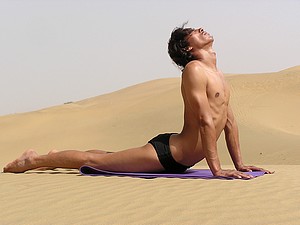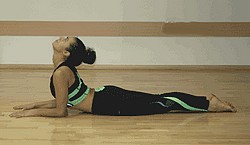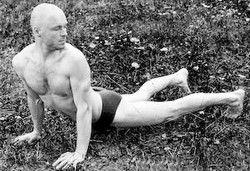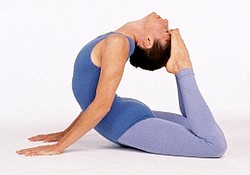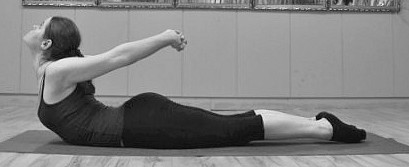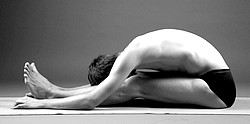I’m planning to gradually describe all the basic yoga poses here, on my blog, so you can always refer to them when following your yoga routine. Bhujangasana is among the basic yoga poses, and it works on strengthening your core muscles, as well as improving the health of internal organs especially in the abdomen area.
What does Bhujangasana Mean?
Bhujangasana in Sanskrit means “the Cobra Pose” – the other well known name of this asana. If you are looking for the pronunciation, it is easily found in many online Sanskrit dictionaries. The name of the pose indicates its origin – the ancient people often watched animals to create a system for maintaining their health or to develop some martial arts. According to the yoga tradition, the cobra pose along with other asanas was given by the Lord Shiva Himself, which does not deny its resemblance to the serpent’s movement.
Bhujangasana Technique
So, how is bhujangasana is done? Here are the detailed instructions.
You need to lie down on your abdomen; use a yoga mat or a blanket, don’t lie on a bare floor. Place your arms along your body and relax for 10-30 second. Then move your arms up and place the palms right under the shoulders or slightly forward but close to them. Your forehead should rest on the floor. With inhale start raising your head slowly (but not too slow – you need to match it with your inhaling). Once you reach your limit, move on, now rising your upper body. Again, once the limit of your efforts is attained (you are doing this lifting only with your back muscles), engage your arms to help you rising further. Once you reached the top position, hold on for a while (while you feel comfortable to stay in the final pose). Then, with exhale, slowly return to the starting position.
Basically, upon reaching the top position in the cobra pose you have two alternatives:
- To hold on and breathe freely and deeply, then return to the starting position;
- Once you have reached the top position on inhale, return with exhale to the starting position right after that; repeat several times.
The first option is more difficult and is suitable for those with some experience. But you can combine both ways just as I do: I repeat the pose few times without holding on the top position, and then I hold on there for few breaths, and return to the floor.
How to Enhance the Cobra Pose
Once you got some experience in the pose, you can go further: upon reaching the top position, make a full exhalation, and with the help of your hands bend your back backwards slightly more until you feel a light painful sensation in the lower back. BUT, never do it until the obvious pain! It should be just a minor painful sensation. If the pain becomes stronger, slowly return to the floor and rest for few minutes, then do shashankasana.
Another way to enhance the pose is to do some head movements: bend it forward and backward, or even gently to the sides.
When you perform bhujangasana, try to straighten your arms fully; if it is not possible in the beginning, don’t worry – it will come after some practice.
Cobra Pose Contraindications
Here is the list of bhujangasana contraindications:
- Peptic ulcer
- Hernia
- Intestine tuberculosis
- Enlarged thyroid gland
Cobra Pose Benefits
Bhujangasana actively affects the abdominal cavity, as well as the excretory and reproductive systems. It is particularly useful for the female reproductive system, because it eliminates or deals with Leucorrhoea (whites), dysmenorrhea and amenorrhea. Cobra pose tones the ovaries and uterus (in fact, the same applies to the male reproductive system), maintaining their health. It deals with constipation, increases appetite, helps to align and strengthen the spinal discs, makes your back more flexible and relieves back pain (cobra pose and back pain are a good match!); it can also help with sciatica. In general, the anatomical focus of the cobra pose is around the abdomen and lumbar area as well as the upper back.
In terms of training, regular execution of the cobra pose strengthens the back muscles, especially the shoulder girdle (in order to strengthen the lower back it is good to do salabhasana or the locust pose in addition to the cobra pose).
Side Effects of Bhujangasana
I don’t know any recorded side effects of the cobra pose (of course, considering the fact that you don’t have any contraindications).
Cobra Pose during Pregnancy
I would not recommend doing the cobra pose during pregnancy. I know that it is sometimes allowed depending on the trimester and the condition of a particular woman. Some women find it OK doing the cobra pose in the first trimester, but it is better to consult with your doctor and/or a professional yoga teacher and therapist who knows you and your condition.
Cobra Pose and Testosterone
In 2004 the teams of scientists in both India and Russia have tested people who did bhujangasana, and they discovered an average testosterone rise of 16 percent. It was also found that cortisol (a hormone that raises the blood sugar and blood pressure) fell by 11 percent.
Cobra Pose Variations
Ardha-bhujangasana or the half-cobra pose – it is an easier option. It can be considered as a cobra pose for beginners. The technique is almost the same as in the case of the regular cobra, but you don’t straighten your arms, instead you keep your elbows and palms on the floor. Sometimes this pose is also called a sphinx pose.
Tiryaka-bhujangasana
In this pose you touch the floor with your toes and being in the top position turn the upper part for your body to the sides, trying to look at the heel of the opposite foot (i.e., if you turned to the left, look at the right heel). This form is used in the practice of Shankh-Prakshalana.
Purna or poorna-bhujangasana or the full cobra pose. Swami Satyananda Saraswati mentions that this form of the pose should be performed by the experienced yogis or kids and teenagers who have flexible backs (but they should do it under the proper supervision).
In this form when you reach the final position with your arms fully stretched, you need to bend your knees moving the feet closer to the body, and throw back your head so that the head and feet touched. This form is very difficult, so you shouldn’t try practicing it until the main form of the pose is mastered.
Purna bhujangasana should not be done if one has spinal problems.
One more simple option is called sarpasana – when you raise your body above the floor, you don’t use your hands at all; instead, you bind your hands behind the head.
Bhujangasana Counterpose
I forgot to mention one more thing – a counter pose for the cobra pose. Th best one here is paschimottanasana or the seated forward bend. Alternatively you can do shashankasana; adho-mukha-svanasana and padahastasana can also be acceptable depending on your particular routine.
